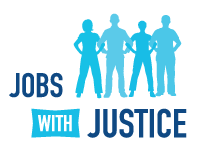Change can be exhilarating and inspiring, while simultaneously anxiety-inducing. As a movement, we know how to navigate current systems – whether it be policy or labor institutions – but singular paths can create unimaginative and exclusionary practices. Is it time for a new movement playbook, or just a more nimble one?
“We thought Amazon was impenetrable. Even just four years ago. Now we know that’s not the case.”
Erica Smiley, Executive Director of Jobs With Justice dives into this topic and the exciting possibilities of a worker-led movement building democracy on the latest episode of Audie Cornish’s, The Assignment. They’re joined by Starbucks Worker United organizer Nabretta Hardin of the Memphis 7.
“What we’re seeing now is an upsurge in a movement. A new movement of workers trying to figure out how to organize and essentially practice democracy at work and the current protocols and protections that were won previously in 1935, for example, don’t necessarily fit.”
There is no doubt the global covid-19 pandemic was a catalyst in the resurgence of the labor movement in the United States. Workers, dubbed “essential”, saw corporations rake in billion dollar profits while they struggled to keep a roof over their families’ heads and food in their bellies. Far-right disinformation was rampant, and managers failed to keep employees safe. Workers at corporate giants like Amazon and Starbucks began to break through what was once considered an impenetrable force.
A new generation of workers are demanding more than benefits and better pay. They are demanding dignity and a seat at the table, organizing through legacy unions or in new groups popping up around the country.
“The new generation taking to the streets today are the ones who are winning. And that’s saying something to those who have been naysayers historically. I think that’s the magic of this moment, and why as anxiety producing as it can be for a lot of us, is why it feels like we’re on the upsurge – on a win.”
Smiley notes that this new generation doesn’t necessarily refer to “young” or “old” workers. While Zoomers like Nabretta Hardin are leading Starbucks Workers United in Memphis and beyond to major victories, the growing number of organized workers are multi-generational. From fast food workers in the south to baristas in Buffalo, these workers are finding strength in the diversity of their communities and workplaces. And their demands are reflecting that.
“When unions and institutions are at their best, they are investing in new organizing and not just in existing contracts, and making sure that the organizers are workers. That is a labor movement at its best.”
The union support of Workers United in the formation of Starbucks Workers United demonstrates the nimbleness the labor movement needs to sustain. Expanding resources from the negotiation table to the streets alongside organizers will help grow worker power and solidarity across the country.
Igniting the future of the movement also means funding worker organizers who are increasingly victims of retaliation, uniting across industries, and continuing to celebrate workers as unique, whole individuals deserved of dignity in and out of the workplace.
“This is why we define workers as whole people when we talk about organizing.You might be a Presbyterian, maybe you play soccer. You have all of these identities and we want you to have dignified lives. The purpose of organizing, the purpose of movements, isn’t just to win a particular issue or a particular right. It’s to win long term dignity, sustainability, and the ability to engage in decision making for all aspects of your life forever.”
Listen to the full episode of “The New State of Unions” above or at cnn.it/3XCKUBs.
